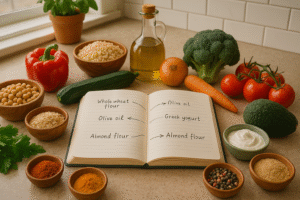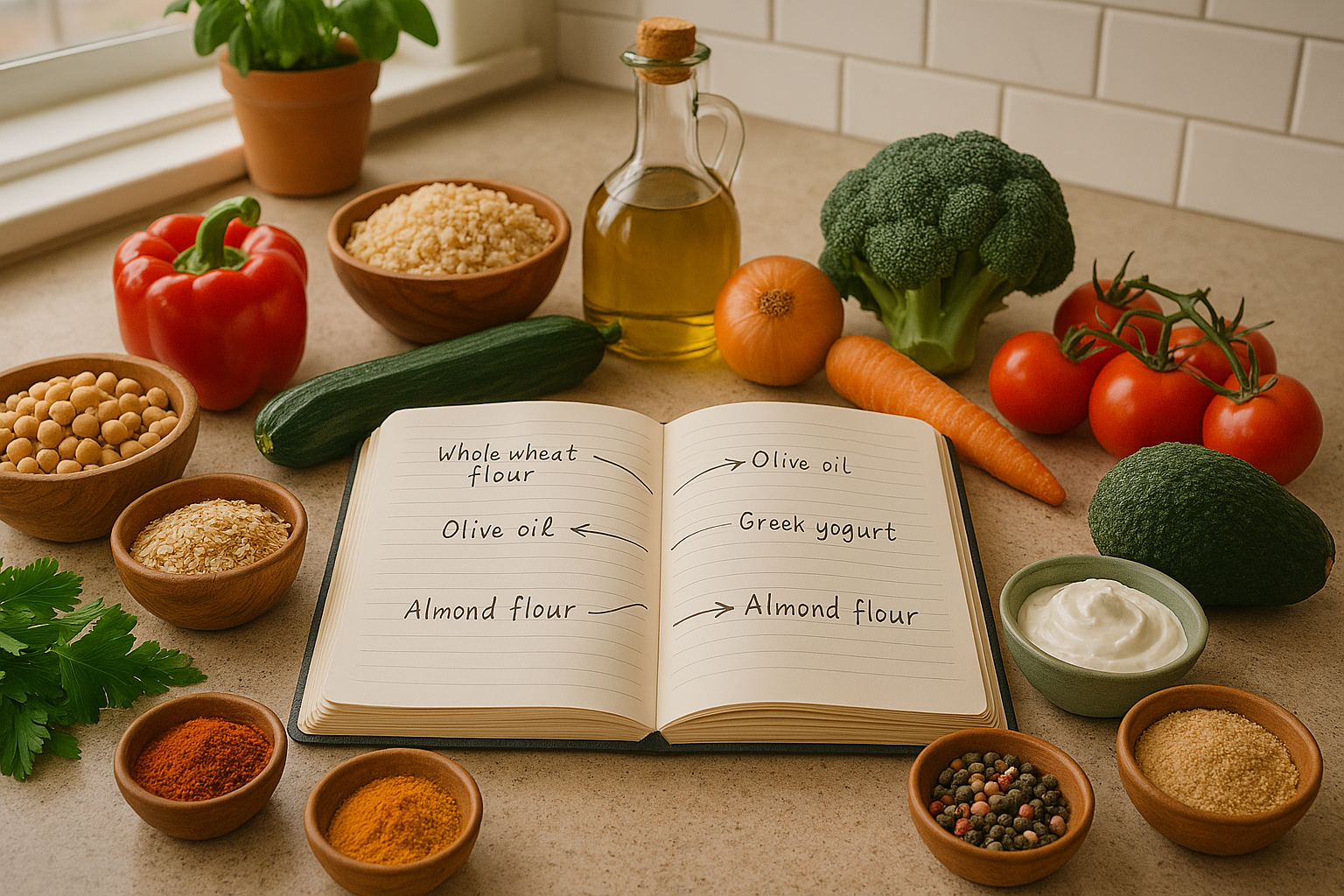Everyday Recipe Modifications: Simple Tweaks for Healthier, Tastier Meals in 2025
In today’s fast-paced world, cooking at home is no longer just about tradition it’s about health, sustainability, and convenience. As we step into 2025, the culinary landscape is evolving with smarter, more mindful eating habits. One of the most accessible ways to embrace this shift is through everyday recipe modifications small, strategic changes to your favorite meals that boost nutrition, flavor, and functionality without sacrificing taste.
Whether you’re a beginner in the kitchen or a seasoned home cook, this guide will walk you through practical, science-backed ways to modify recipes for better health, sustainability, and satisfaction.
Why Modify Recipes?
Recipe modifications are more than just trendy they’re transformative. Here’s why they matter:
- Improve nutritional value without overhauling your diet.
- Accommodate dietary restrictions like gluten-free, vegan, or low-sodium needs.
- Reduce food waste by using what you already have.
- Save money by replacing expensive ingredients with affordable alternatives.
- Customize flavors to suit your preferences or cultural tastes.

1. Healthier Ingredient Swaps
One of the easiest ways to modify a recipe is by swapping out less nutritious ingredients for healthier alternatives.
Common Substitutions:
| Original Ingredient | Healthier Swap | Benefit |
|---|---|---|
| White flour | Whole wheat, oat, or almond flour | Adds fiber and nutrients |
| Butter | Mashed avocado, Greek yogurt, or olive oil | Reduces saturated fat |
| Sugar | Mashed banana, dates, or stevia | Lowers glycemic impact |
| Sour cream | Greek yogurt | Adds protein, reduces fat |
| Heavy cream | Coconut milk or cashew cream | Dairy-free, lighter option |
| Salt | Herbs, lemon juice, or spices | Enhances flavor without sodium |
Expert Tip: “Start with a 25% substitution to test how the new ingredient affects texture and taste,” says Dr. Maya Patel, a registered dietitian and food scientist.
2. Cooking Method Makeovers
How you cook matters just as much as what you cook. Swapping cooking methods can drastically reduce calories and harmful compounds.
Try These Modifications:
- Bake instead of fry: Use an air fryer or oven to get crispy textures with less oil.
- Steam instead of boil: Retains more nutrients in vegetables.
- Grill instead of sauté: Adds smoky flavor without extra fat.
- Slow cook instead of deep fry: Ideal for tender meats and legumes with minimal oil.
3. Portion Control Without Sacrifice
Portion sizes have ballooned over the years. Here’s how to scale back without feeling deprived:
- Use smaller plates to trick your brain into feeling full.
- Add volume with vegetables they’re low in calories but high in fiber.
- Serve sauces on the side to control how much you consume.
- Replace half your pasta with zoodles (zucchini noodles) or spiralized carrots.
Stat to Know: According to the World Health Organization, reducing portion sizes by just 20% can lead to a 10–15% decrease in daily calorie intake.
4. Flavor Boosters That Don’t Add Calories
Flavor doesn’t have to come from fat, sugar, or salt. Here are some zero-calorie or low-calorie ways to enhance taste:
- Fresh herbs: Basil, cilantro, mint, and parsley
- Spices: Turmeric, cumin, smoked paprika, cinnamon
- Acidic elements: Lemon juice, vinegar, tamarind
- Umami-rich ingredients: Mushrooms, nutritional yeast, miso paste
Case Study: A 2024 study by the Culinary Institute of America found that using herbs and spices instead of salt reduced sodium intake by 30% without affecting taste satisfaction.
5. Smart Modifications for Special Diets
Whether you’re gluten-free, vegan, keto, or just trying to eat cleaner, recipe modifications can help you stay on track.
Gluten-Free:
- Use almond flour, rice flour, or certified gluten-free oats.
- Replace soy sauce with tamari or coconut aminos.
Vegan:
- Swap eggs with flaxseed meal (1 tbsp flax + 3 tbsp water = 1 egg).
- Use plant-based milks and cheeses.
Low-Carb/Keto:
- Replace rice with cauliflower rice.
- Use lettuce wraps instead of bread.
6. Sustainable Swaps for Eco-Friendly Eating
In 2025, sustainability is a key driver in recipe innovation. Here’s how to cook with the planet in mind:
- Use seasonal produce to reduce carbon footprint.
- Incorporate plant-based proteins like lentils, beans, and tofu.
- Repurpose leftovers into soups, stir-fries, or grain bowls.
- Buy in bulk and store in reusable containers to cut packaging waste.
Expert Insight: “Sustainable cooking isn’t about perfection it’s about progress. Even one meatless day a week can make a difference,” says Chef Laila Noor, author of Green Kitchen Habits.
7. Real-World Example: The Modified Mac & Cheese
Let’s take a classic comfort food and give it a healthy twist:
Original Recipe:
- Elbow macaroni
- Butter
- Whole milk
- Cheddar cheese
Modified Version:
- Whole wheat or chickpea pasta
- Olive oil or Greek yogurt
- Unsweetened almond milk
- Nutritional yeast + low-fat cheese blend
- Add-ins: steamed broccoli, spinach, or peas
Result: A fiber-rich, lower-fat version with added veggies and protein without sacrificing the creamy goodness.
8. Practical Hacks for Everyday Cooks
- Batch cook sauces and freeze in ice cube trays for quick flavor boosts.
- Use a food processor to sneak veggies into sauces, soups, and even baked goods.
- Label and date leftovers to avoid waste and keep your fridge organized.
- Keep a “substitution cheat sheet” on your fridge for quick reference.
Conclusion: Small Changes, Big Impact
Everyday recipe modifications are a powerful tool for anyone looking to eat healthier, reduce waste, or simply enjoy cooking more. By making small, intentional changes, you can transform your meals into something more nourishing, sustainable, and satisfying without losing the joy of food.
FAQ: Everyday Recipe Modifications
1. Can I modify any recipe to be healthier? Yes, most recipes can be adjusted with ingredient swaps or cooking methods. Start small and test changes gradually.
2. Will modifying a recipe affect the taste? Sometimes, but often in a good way! Many healthy swaps enhance flavor and texture.
3. How do I know if a substitution will work? Look for similar textures and moisture levels. For baking, follow tested substitution ratios.
4. Are there tools to help with recipe modifications? Yes! Apps like Yummly, Whisk, and MyFitnessPal offer substitution suggestions and nutrition tracking.
5. What’s the best way to reduce sugar in desserts? Use mashed fruits, dates, or natural sweeteners like stevia or monk fruit.
6. How can I make recipes more kid-friendly? Blend veggies into sauces, use fun shapes, and involve kids in the cooking process.
7. Is it expensive to cook healthier? Not necessarily. Buying in bulk, using seasonal produce, and reducing meat can actually save money.

Casino mirror is trusted by thousands of users
🔥 Микрокредиты Казахстан — топ без отказа
Игра Лаки Джет с мгновенным выводом на 1WIN!
Casino mirror ensures you never miss a spin
Access slots and table games via casino mirror